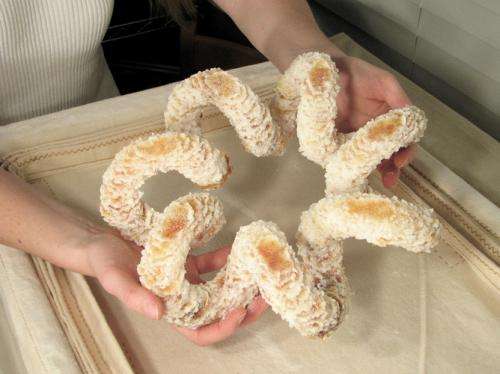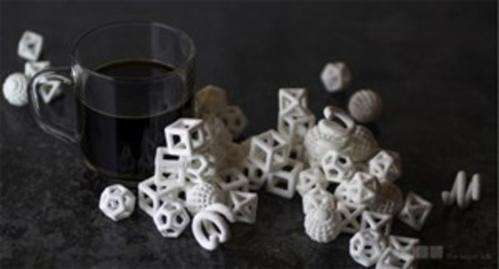The ultimate iron chef: When 3-D printers invade the kitchen

Printing food seems more like an idea based in Star Trek rather than in the average home. But recent advances in 3D printing (known formally as additive manufacturing) are driving the concept closer to reality. With everything from printed metal airplane wings to replacement organs on the horizon, could printed food be next? And how will we feel when it's served at the table?
From sundaes to space food
In some ways we have "printed" food for decades. Think of making a sundae using a self-dispensing ice-cream machine. Building by extruding material through a nozzle is quite similar to how certain 3D printers, called fused deposition modellers (FDM) work today. While FDM is primarily used for prototyping plastics, the technology has been applied in culinary arts for years.
Researchers at Cornell pioneered some of this work, adapting an open source extrusion printer, called the Fab@Home Lab, to work with food in 2007. They've gone so far as partnering with the French Culinary Institute in Manhattan to print personalised chocolate and cheese, cookies, cubes of pureed turkey and celery paste, and even tiny spaceships made of deep fried scallops.
Novelty food suppliers have become early adopters of similar technology. Various chocolate printers are on the market, and for Valentine's Day in Japan this year you could order chocolate made from a 3D scan of your face. Further examples include a Burritobot on Kickstarter last year and Google serving 3D printed pasta.
Other 3D printing technologies have been investigated for use with food. In 2007, Evil Mad Scientist Laboratories introduced the CandyFab 4000, a DIY printer based on a modified selective laser sintering technique. The method utilised a focused heat source moving over a bed of sugar to fuse large 3D sugar sculptures. And just a few months ago, a team of students from the University of Waterloo was able to sinter chocolate using a custom built machine.
Established market players in Additive Manufacturing have taken notice as well. In September, 3D Systems (NYSE:DDD) acquired The Sugar Lab, a startup producing edible 3D sugar confections. The Sugar Lab had adapted 3D Systems' Color Jet Printing (CJP) technology to print flavoured edible binders on a sugar bed to fabricate solid structures.
Beyond novelty, printed food could provide serious medical benefits. The Netherlands Organisation for Applied Scientific Research (TNO) announced they'll build printers to reassemble pureed food to look like the original – think 3D printed broccoli florets from pureed broccoli. TNO has targeted printers for nursing homes in order to help elderly people who have chewing and swallowing problems. Beyond medical conditions, TNO has proposed printing customised meals with varied levels of the basic food components like carbs, protein, and fat, for everyone from seniors, to athletes, to expectant mothers.
And NASA sees 3D-printed food as a revolutionary way to make personalised meals for astronauts. They are funding development of a 3D printer that premixes basic food components before spraying the mix on baking tray. Their ultimate goal would be to print a pizza. Beyond providing cosmic delivery, food would also be tailored for astronauts' daily activities.
The ethics of printed meat
Will printed food go beyond novelty value? Should it replace other foods or supplement the nutritional value of existing foods? In this area, one of the most interesting and perhaps controversial areas is the debate about printing meat.

Some suggest 3D printed meat could provide high quality protein for a growing global population without increasing stress on arable land or continually depleting the oceans. It could also answer the problem of methane emissions from agriculture.
In 2011 Modern Meadow took up the challenge, setting out to make ecological and economical leather and meat from bioprinters. They cultured biopsied bovine cells to produce sheets of tissue, eventually forming either meat or hide. They predict cultured leather will be on the market in five years.
Modern Meadow's CEO Andras Forgacs is a pioneer in the bioprinting field cofounding the tissue printing company Organovo (NYSE:ONVO) with his father Gabor Forgacs. In 2011, Gabor – the Chief Scientific Officer at Modern Meadow, cooked and ate cultured pork live at a TEDMED conference.
Currently, it is very expensive to produce tiny volumes of printed meat, with estimates of thousands of dollars to make a pound of meat in the lab. But could the process be scaled up, and cell cultures made cheaper?
Biopsies aren't the only sources for culture. The process could potentially use stem cells. Industrial scale printing of meat could additionally use cells grown in an algae-based cell culture and powered by novel processes such as photosynthesis-mimicking solar energy systems.
For vegetarians, printed meat somewhat circumvents concerns about harmful or destructive use of animals for food. Live animals are used only to provide cells from which cell lines can be grown (though the blood of unborn cows is needed to culture most cells).
Ethical vegans may still object at the use of non-human animals for human purposes; while non-destructive, it is still exploitative.
It isn't clear whether 3D printed meat is halal or kosher. There may not be an issue if there is no animal slaughter involved.
Will we stomach it?
While we typically "eat with our eyes", and printed meat could be made in familiar shapes and textures, our palate will be the dominating factor. That is, if printed meat could be proven safe.
Printed meat may result in a debate akin to that on GMO foods. Certainly the public will want to know whether printed foods are safe for human consumption.
Consumers will most likely demand adequate protections to ensure the development of printed foods does not limit their access to or contaminate organic foods. It is reasonable to assume most will want to decide whether they eat "real" meat or try printed meats, so labelling regulation will be important.
Farming communities and those in agricultural food production will also want a voice about if, when and how their industry will be transformed by industrialised printed meat.
Early identification or those affected, and extensive engagement with the range of community concerns about printed foods, is warranted. While no specific printed food exploration exists yet, similar forms of community engagement have been developed in Australia through the Science and Technology Engagement Pathways framework (STEP). They work with communities on a wide range of issues, including synthetic biology and bionic implants.
STEP has supported researchers in the ethics program at the Australian Research Council Centre of Excellence for Electromaterials Science, who are identifying effective public engagement and deliberative democratic processes for uncovering and articulating community concerns about emerging technologies. Other entities like RiAus, an Australian non-profit, has been active in stimulating community debate specifically about synthetic meat.
The proof is in the print
With no slow-down in 3D printing developments, there will certainly be new advances in printed food. Whether the technology can truly move from the novelty sector will most likely depend on the ability to process a wider range of foods requiring influence from both the kitchen and from printer developers.
It is also debatable whether 3D printed food can integrate in the global supply chain, particularly if printed meat can be made economically viable and if consumers will accept it. However, the benefits of 3D printed food could be monumental. Time will tell if the next fad will be the 3D printed diet. Until then, the community should be involved in the discussion of printed food.
Source: The Conversation
This story is published courtesy of The Conversation (under Creative Commons-Attribution/No derivatives).
![]()




















